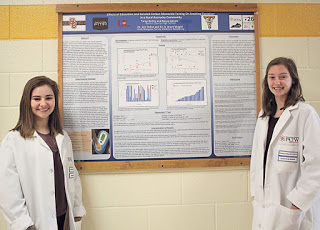High-school students’ research finds smokers are more likely to want to quit smoking after seeing their carbon monoxide levels

 |
| Taryn Kerley and Becca Calvert, Barren County High School seniors |
Cigarette smokers who saw their carbon monoxide levels rise after they smoked were more likely to want to quit smoking, according to a study led by two students at Barren County High School, Will Perkins reports for the Glasgow Daily Times.
CO is a poisonous, colorless and odorless gas that is produced as a result of the incomplete burning of combustible products. When a person smokes, carbon monoxide enters the blood through the lungs and blocks its ability to carry oxygen to body cells.
The study, “Effects of Education and Exhaled Carbon Monoxide Testing on Smoking Cessation in a Rural Kentucky Community,” was led by Taryn Kerley and Becca Calvert, both seniors who are part of the high school’s nationally certified Project Lead the Way Biomedical Science program, Perkins reports.
The study included 30 participants, who ranged in age from 16 to the 50s, at a band competition.
“We would ask people who came to our table if they smoked,” Calvert said. “If they did, then we would talk to them about carbon monoxide and how it affects the body, and if they already knew that beforehand. We would ask them to rate themselves on a scale of one to 10, if they wanted to quit smoking and how much. Then we would use a smokerlyzer to get their carbon monoxide reading.”
Clavert told Perkins that participants were asked to hold their breath “for a really long time” and then blow smoke into a smokerlyzer, a device that tells how many parts per million of CO a person has in their lungs.
After the participants used the smokerlyzer, they were shown their results and asked again how they rated their desire to quit smoking, and if it had changed.
Kerley told Perkins that data showed that “there was a significant difference in the desire to quit smoking from before they saw their level to after they saw their carbon monoxide level.”
However, Kerley and Calvert said long-term smokers were less likely to change their desire to quit smoking after getting their results.
“If people had been smoking for a longer amount of time, like say, 20 to 30 years, and they smoked at least a pack a day, then they were less likely to change their desire to quit because they had gotten to a point of no return in their smoking habits,” Calvert said,
Calvert also noted that the younger smokers made a game out of the smokerlyzer, trying to see who could get the highest readings, but the older participants didn’t want to know how bad their results were.
Kerley and Calvert worked with Eric Fisher, assistant professor at the University of Louisville/ Glasgow Family Medicine Residency, and Brent Wright, associate dean of rural health innovation at UofL/ Glasgow FMR on their research. They presented their findings in Frankfort, along with other student researchers.